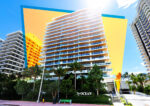Trending
Two Sutton Place North adds touch of class to old-fashioned enclave: Architecture review

The Name Sutton Place no longer charms the ear as it did in the immediate aftermath of WWII. To people of a certain age, it still holds the magic of an incantation, but these days the rest of the beau monde is looking to the Meatpacking District and Brooklyn.
Within this context, two new towers — one complete, the other recently topped out — might seem like a perfect fit. Though they lack the prewar charm of 2 Sutton Place South, a prewar co-op building designed by Emery Roth, their modernist vocabulary, as designed by the firm of Davis Brody Bond, recalls a time when the architectural language of mainstream modernism seemed positively pregnant with global consequence.
In fact, the new tower, 2 Sutton Place North, like its completed fellow 1 Sutton Place North, takes us back to the early 1970s, with its austere minimalist-inspired forms. Both buildings appear to be more or less identical, each consisting of two thin plains almost touching, though slightly uneven in their overlap. They are both uninterrupted curtain walls of dark glass that surely has antecedents in Trump World Tower, designed by Costas Kondylis, and in the Millenium Hotel near Ground Zero, designed by Eli Attia. Indeed, the same developer, Sheldon Solow, working with the same architectural firm, then known as Davis, Brody Associates, created a very similar, though far inferior building at One East River Place, on 72nd Street, 25 years ago. Whereas that building’s proportions were lumbering and maladroit, the latest version is far more graceful and deftly handled.
The new tower, to be completed in 2014, will contain 43 stories and rise to 450 feet, which no longer seems that tall for a Manhattan residential structure. While 1 Sutton Place North contains 234 rental units, details of the apartment breakdown at its sister building have been sparse. Though these new arrivals will not necessarily play well with some of the more traditional buildings in their vicinity, they will add to the area “a touch of class,” as people used to say, half a century ago.




